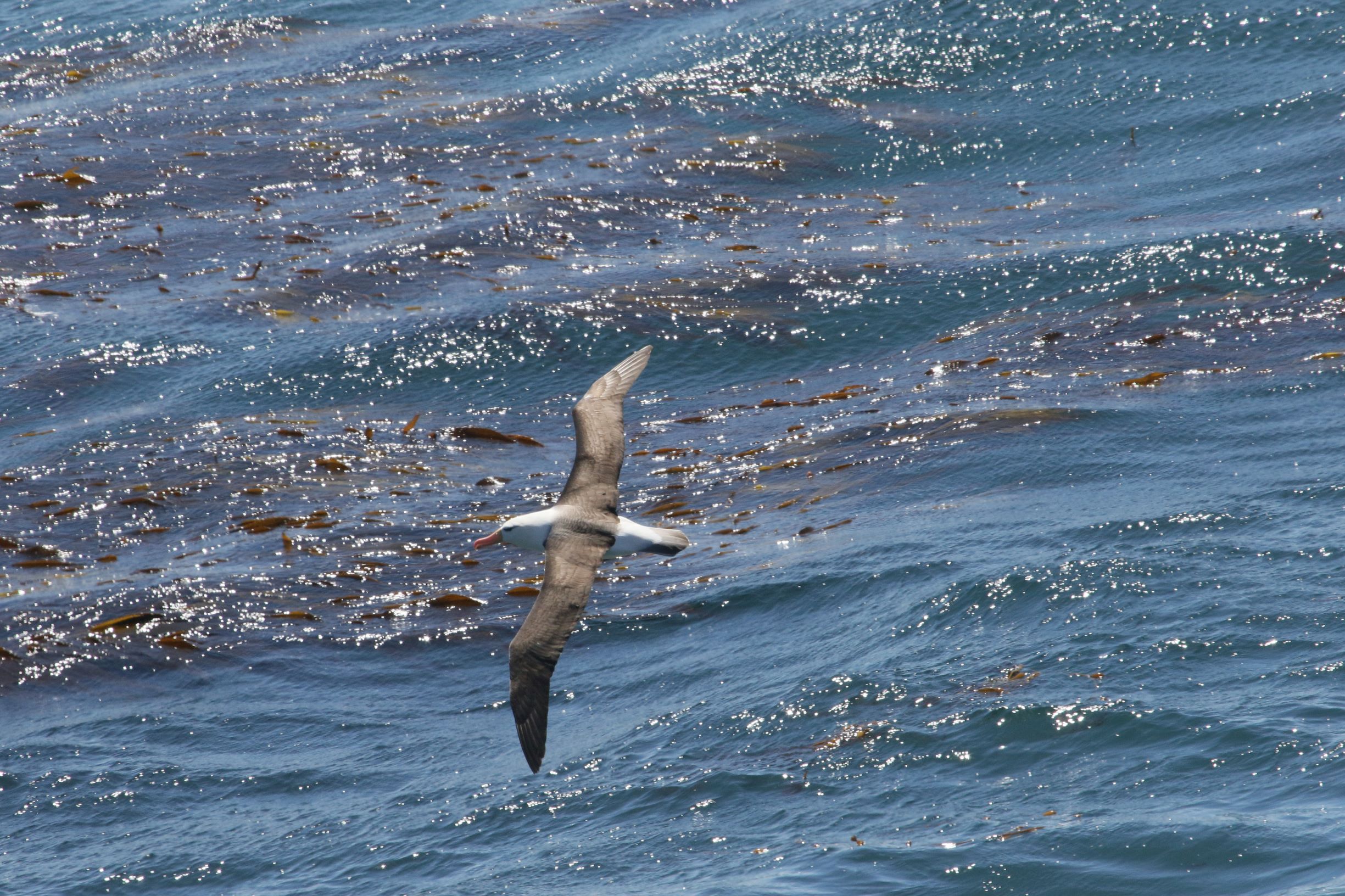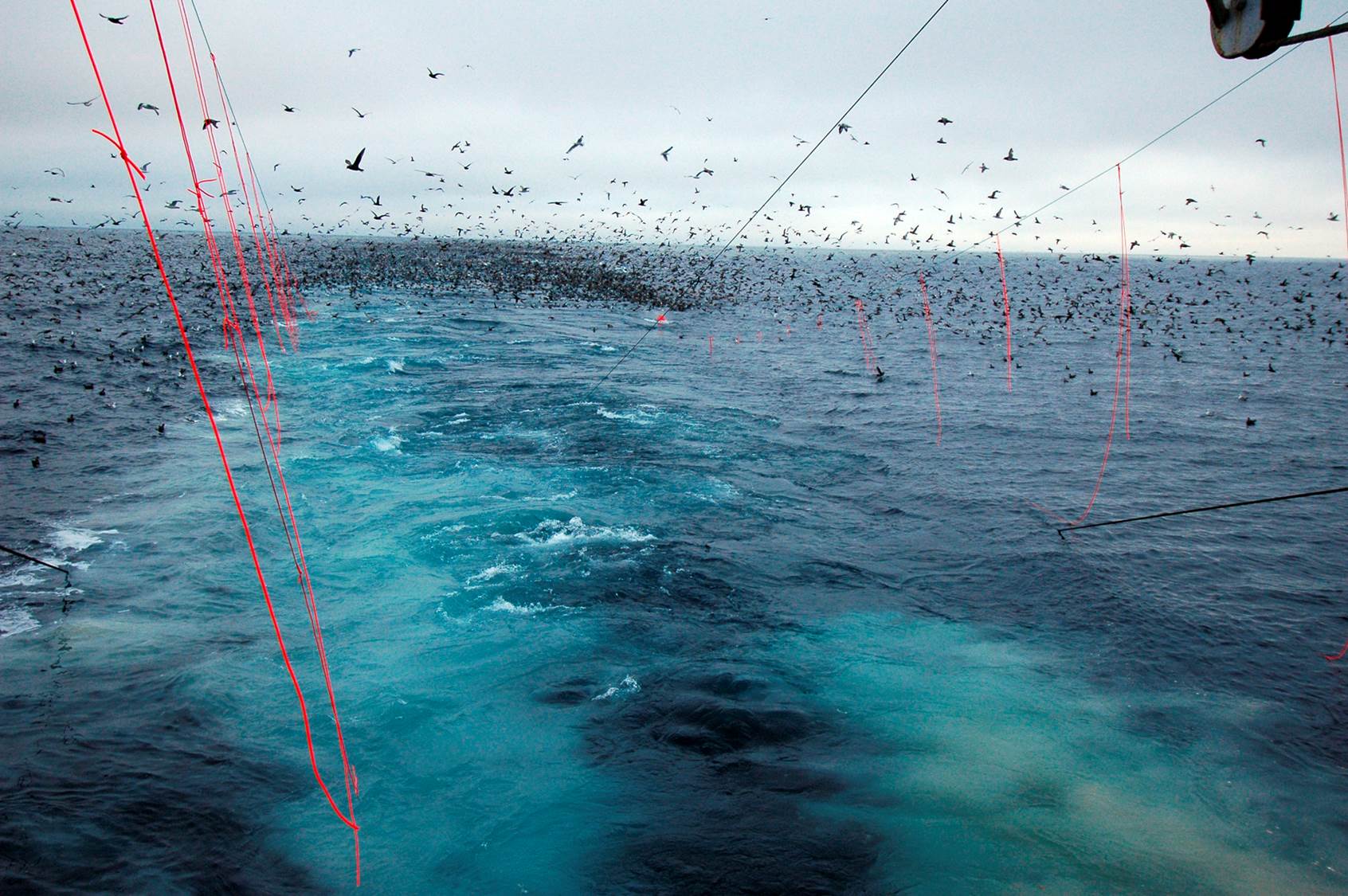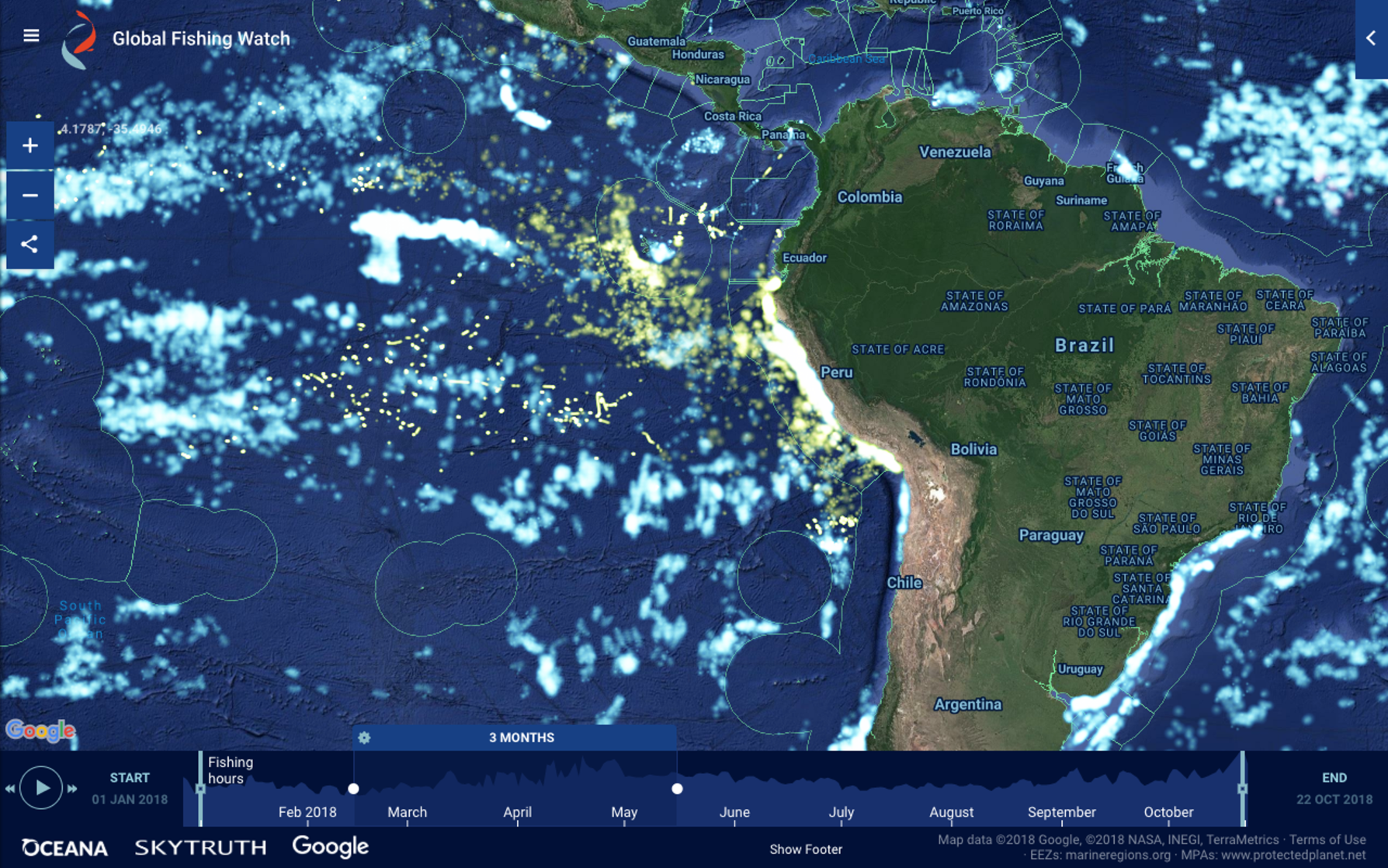- In an effort to reduce albatross deaths as bycatch of longline fishing, Global Fishing Watch (GFW) and Birdlife International researchers are using machine learning models to determine if fishing vessels are setting their lines at night, a recommended technique to avoid accidentally killing albatrosses.
- Mapping fishing vessel behavior involved training new models to recognize when a long-line ship is setting its line.
- This new application broadens the range of GFW’s toolkit to combine machine learning and public data to protect marine wildlife and better manage fisheries.
- Results of the new algorithm formed the basis of a January 2019 regulatory decision by the South Pacific Regional Management Organization.
In a classic poem, an ancient mariner finds himself haunted by the albatross he killed.
Two hundred years after Samuel Coleridge penned that poem, albatrosses still follow fishing ships. But unlike the ancient mariner, today’s longline fishers kill albatrosses by the tens of thousands every year. Trailing lines of baited hooks for as many as 129 kilometers (80 miles) in a vast gray sea, longline vessels set forth a bounty of seafood that the large birds find hard to resist. The birds often bite into a tortured, drowning death.
Now, scientists are combining fishing data and machine learning to keep the birds safe at sea.
An albatross’s outstretched wings may span 3.4 meters (11 feet), and its locking wing joint allows it to soar as many as 16,100 kilometers (10,000 miles) without flapping.

“Albatrosses are fantastic fliers,” said Stephanie Winnard, an albatross task force specialist with Birdlife International. “They use dynamic soaring to achieve this, which is basically gaining height using wind and then turning and swooping over and over again. This requires no flapping at all and expends almost no energy, allowing them to soar for thousands of kilometers.”
Winnard spent three years monitoring albatrosses on South Georgia’s Bird Island, home to between 12 and 50 percent of the world’s wandering, grey-headed, and black-browed albatrosses, according to a 2017 study by Deborah Pardo and colleagues. That study showed found that these albatross populations had declined by 40 to 60 percent over the past 35 years and that substantial incidental mortality (bycatch) in multiple fisheries was contributing to the decline.
Albatrosses are daytime fishers that set out at just before dawn to find food. So one practice recommended for reducing albatross bycatch is to drop fishing lines in the water only at night. To find out what percentage of fishing vessels were actually doing this, Winnard teamed up with David Kroodsma, director of research at Global Fishing Watch (GFW).
“Currently, there is very little observer coverage in high seas fisheries,” Winnard said, “typically 5 to 10 percent. So countries themselves have a poor handle on what is going on at sea.”

By examining fishing vessel movement patterns over time using automatic identification system (AIS) data, GFW machine learning tools could already identify fishing vessels as trawler, longline, or purse seine. Answering Winnard’s question on timing of line setting involved training a model to identify the signature of a longline vessel setting out fishing lines.
“It’s pretty much training a new model using new labeled data,” Kroodsma said.
On-the-sea verification
Winnard’s project team had field experience serving as monitors on longline fishing vessels. This helped the training process.
“We have that at-sea experience that GFW lacked,” Winnard told Mongabay. “We were able… to say when a vessel was starting to set fishing line (using pattern of movement, speed, and direction), when it finished setting the line, the duration of fishing, and when they were hauling in the line. We shared this knowledge with GFW and trained their staff at recognizing this fishing behavior.”
The experience among Winnard’s group also helped test the model. “We used data from fishing trips we had been on, where we knew the exact fishing times, that could be used to check the algorithm against for accuracy.”
The study compared when the vessels set and hauled in their lines, as predicted by GFW neural network algorithms, to the timing of dawn and dusk at the vessel’s location to determine compliance with night setting.
The results of the Birdlife-GFW collaboration showed very low usage of the night-setting mitigation method, slightly more than 15 percent of more than 15,000 vessels in the study. Often, the vessel may have started out at night but continued setting through the dawn hours – the most likely time to attract a hungry albatross.

Though the news was disappointing, it didn’t necessarily point to non-compliance on the part of fishing vessels. They have two other bycatch abatement methods to choose from. One low-tech method entails equipping their longlines with bird-scaring streamers. In Namibia, which has taken strong conservation measures on behalf of sea birds since 2014, these streamers are made by local community women, raising not only their income but their interest in the albatross.
Namibian fishers were, at one time, killing some 30,000 birds each year, so both Global Fishing Watch and Birdlife International’s albatross conservationists have begun studying the Namibian program with interest.
Two of Kroodsma’s teammates are going to Namibia later this month to collect the fishing data.

Longline fishers can also prevent albatross bycatch by adding weights to their lines so the bait will sink before luring in the albatross. In countries that have joined Regional Fisheries Management Organizations (RFMOs) fishers must now implement two of these three abatement methods. But the night setting option, being behavior-based, can’t be monitored in port, which is why Winnard’s data provide an important missing piece of the management puzzle.
The study compared the start and end of sets, as predicted by GFW algorithms, to the timing of dawn and dusk at the vessel’s location to determine compliance with night setting.
Although some countries have self-reported using 85 percent night sets, only 15 percent of vessels set their lines fully at night (completely within the hours of dusk and dawn), a very low level of compliance. Eighty-five percent of line sets were conducted with more than a two-hour overlap with daylight, when albatrosses are awake and hungry.
“The exciting thing about this study,” said Winnard, “is for the first time, we know if boats are night setting, and, in turn, so can the countries these boats belong to.”
The future of high-seas management
Taken with other investigative tools, the GFW models and data analyses are increasingly providing dependable evidence in regulatory compliance cases.
The most recent example was a decision made in January by the South Pacific Regional Fisheries Management Organization (SPRFMO), which regulates waters beyond the Peruvian exclusive economic zone (EEZ). Fishing activities in this area have become easier for Global Fishing Watch to analyze thanks to a decision by the Peruvian government to make their private vessel monitoring system (VMS) data available through the GFW platform.

For example, GFW data were able to track movements of the Vladivostok 2000, a huge fishing vessel, and show likely transfer activities between it and a refueling ship. This constituted a violation of SPRFMO regulations.
In a January 2019 decision, SPRFMO issued the Vladivostok 2000 a “priority non-compliance” status, which lists it among vessels engaged in illegal, unauthorized, or unregulated (IUU) activities. The issuance means the ship cannot receive aid or service from any port or ship of a SPRFMO member state – no refueling or offloading of cargo (transshipment) within the managed seas.
Regional fisheries management organizations (RFMOs) are an imperfect but evolving way to manage fisheries and protect wildlife on the high seas. RFMOs are collaborative agreements among stakeholder nations. The ability of these organizations to enforce policy comes down to two things: the commitment of diverse member states to abide by the rules and the effectiveness of compliance monitoring.

Time-lapse of longline fishing vessels tracked with Global Fishing Watch’s AIS data are seen in blue. The addition of Peru’s VMS data, shown in yellow, instantly put 1,300 of their industrial fishing vessels on the map. Most of these vessels are not active on AIS. For Peru alone, therefore, that represents a 10-fold increase in the number of vessels that are now publicly trackable via Global Fishing Watch.
That the South Pacific RFMO based its status decision on GFW analysis is an example of how data-driven evidence of (non)compliance can empower enforcement, an evolutionary step for fisheries management.
GFW-driven transparency on the horizon
Lacey Malarky of the NGO Oceana told Mongabay she hoped the January SPRFMO decision would show the value of public VMS data and convince more countries to follow Peru’s lead. Malarky said she expected to see more countries willing to make their fisheries data available.
Albatross research may also produce some new developments in 2019. Winnard said her team’s latest albatross tracking results indicated that juvenile birds were spending their time in new Atlantic destinations. Winnard and her team are now analyzing the data to determine how safe the new environments are from the risks posed by fisheries.
In a separate project, Leigh Torres, assistant professor with the Geospatial Ecology of Marine Megafauna (GEMM) lab at Oregon State, has been analyzing albatross tracking data to understand the mechanisms in play when bird meets ship.
“Our project examines the fine-scale overlap between albatross and fishing vessels using the Global Fishing Watch dataset,” Torres told Mongabay. Her work investigates why some albatrosses are attracted to fishing vessels and others are not.
“We are evaluating multiple potential factors,” Torres said, “including bird species, age and behavior, fishing vessel type, size and target fishery, and environmental influences like temperature and wind.” Torres will report her findings at a conference in late February.
GFW’s Kroodsma said analyzing Torres’ data on boats and birds helped reveal potential risky environments for albatrosses. By overlapping data on movements of both the longline vessel and the albatross, Kroodsma said, “you can see when the two meet up and travel together – and that’s when you can tell that they’re at risk of being bycatch.”
Targeted outreach
Training the GFW algorithms to recognize the detailed movement patterns a fishing vessel makes while setting or hauling in a longline to determine whether ships set their lines at night has given the groups a tool for their global efforts to save the albatross in largely unmonitored tuna fisheries.
“It allows NGOs and other interested parties to have a clearer understanding of use of [mitigation] measures in these fisheries,” Winnard said. “And when countries report on percent use of measures (which isn’t always made public but we see the reports in closed meetings), we can challenge those that don’t match the GFW data.”

The Birdlife team plans to include data from more nations and to present their findings to fishers about adapting mitigation practices and at various RFMO meetings to speak on behalf of these measures. They are, for example, working with Taiwan to come up with a bird-scaring line that will work better for their smaller boats.
“We advocate for strong resolutions to protect seabirds,” Winnard says, “and we want to see improved compliance and monitoring for all tuna fisheries.”
Citation
Pardo, D., Forcada, J., Wood, A. G., Tuck, G. N., Ireland, L., Pradel, R., … & Phillips, R. A. (2017). Additive effects of climate and fisheries drive ongoing declines in multiple albatross species. Proceedings of the National Academy of Sciences, 114(50), E10829-E10837. https ://doi.org/10.1073/pnas.1618819114
FEEDBACK: Use this form to send a message to the editor of this post. If you want to post a public comment, you can do that at the bottom of the page.